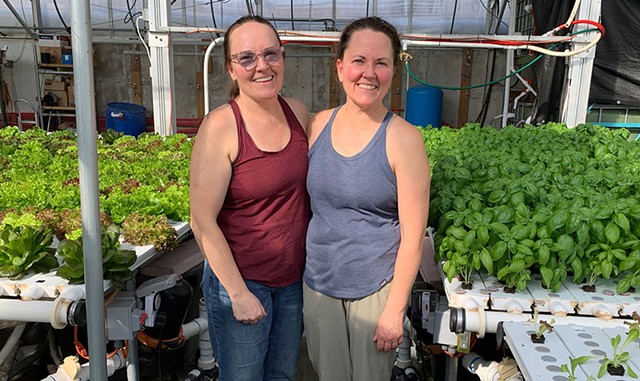
- Melissa Pasanen
- Heather Counter (left) and Holly Counter Beaver at Finn & Roots
In July 2019, Holly Counter Beaver fell in love. She discovered the object of her affection online and began dreaming about a new life direction.
The tech industry veteran, then living in Evergreen, Colo., recounted how she'd distract herself from the tedium of long video meetings by gazing at photos of her crush in another browser window.
But Beaver, now 55, wasn't scoping out potential mates on a dating app; she's been happily married for 26 years. It was a business broker site where she found her Shangri-la in the form of a 209-acre Vermont "eco-farm" for sale.
"I saw it and literally fell in love," Beaver said. "It was my happy place."
She lobbied her husband with an 85-slide presentation. In October 2019, the couple bought the property, which includes land in Bakersfield and Enosburg. For $1.5 million, they purchased a five-bedroom house where they now live with Beaver's sister (and her sole employee), along with hayfields, woodlands, a small orchard and vineyard, and a 6,000-square-foot glass greenhouse/insulated fish house. That structure was home to a then 5-year-old aquaponics farm founded by Shawn and Liz Robinson called Finn & Roots, which promised "fish and greens grown in harmony."
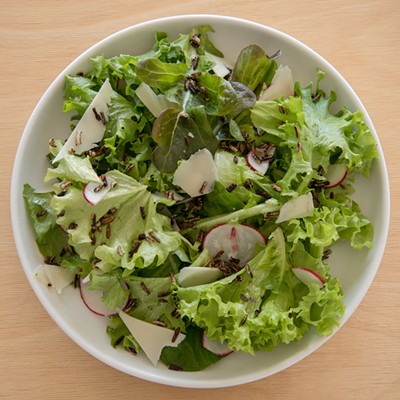
- Daria Bishop
- A Finn & Roots salad with Alpha Tolman, puffed rice and prosecco vinegar at Peg & Ter's restaurant in Shelburne
Aquaponics agriculture couples hydroponics — raising vegetables without soil in nutrient-fortified water — with the farming of fish in a land-based aquaculture system. Ideally, the latter yields both marketable seafood and water naturally enriched with fish waste that nourishes the vegetables in a synergistic loop.
Unfortunately, like many dating profiles, Finn & Roots' online appearance turned out to not quite match its reality. Beaver has spent the past three and a half years studying, troubleshooting and rebuilding the farm's complicated, intertwined vegetable and fish systems. All the while, she has continued to sell Finn & Roots mixed greens, living lettuces with intact roots, basil and cucumbers to about a dozen markets and restaurants, mostly in Chittenden County.
"There was a lot of discovery in those first months," Beaver said, with some understatement. She had promised her husband that the farm would enable him to retire from his tech career, just as she was doing. "I probably shouldn't have," Beaver said ruefully of that promise.
Beaver and her sister, Heather Counter, met with Seven Days on a cold March afternoon on the farm. Outside, the greenhouse was still banked deep in snow, but the sunny day contributed to a tropical 88 degrees inside.
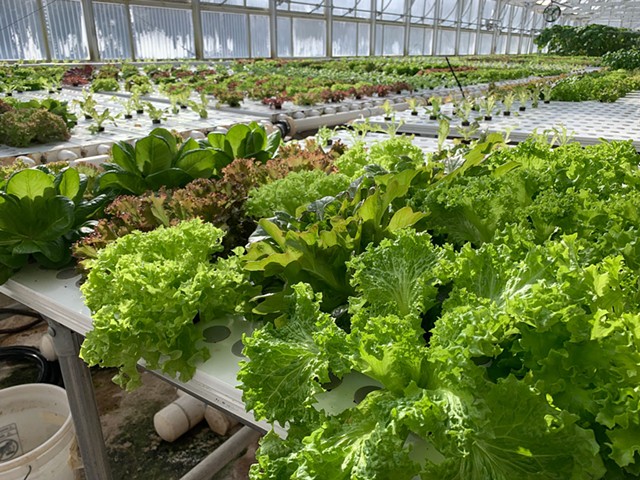
- Melissa Pasanen
- The greenhouse at Finn & Roots
Beyond solar gain, the greenhouse is heated by a propane heater and a wood-fired boiler that Beaver nicknamed Audrey after the insatiable, carnivorous plant in the Little Shop of Horrors musical. "That first year," she said with a grimace, "I could not feed it enough."
The sisters were paying close attention to a new energy-efficient fogger system powered by water pressure. It is among the latest on a long, expensive list of infrastructure improvements they have made to the farm, including replacing fans, investing in dehumidifiers, upgrading the aquaculture filtration system and adding a large solar array in an effort to cover the greenhouse's electrical needs.
Row on row of white hydro-benches held heads of many different lettuces — green and red butter and oak, frilly lollo rosso, crinkle-leafed Batavia — and basil, all at different stages of growth. In one corner, vines bearing glossy cucumbers climbed trellises.
Along the back wall, four huge, jade-green tubs rippled with sleek, shadowy, swimming tilapia. When one splashed to the surface, Beaver cheerily said, "Hi, fishies!"
The first 18 months after Beaver took over the farm were not so cheerful. That was how long she needed to get a handle on the operation, starting with managing overcrowded fish tanks that were clogged with waste. "Every day, I'd come out and there'd be something wrong with the [fish] nursery," she recalled. "Every day, I would cry and wail: 'Oh, my God, what have I done?'"
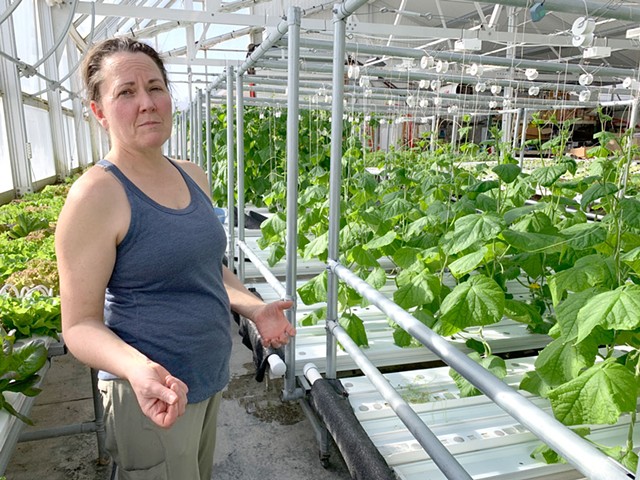
- Melissa Pasanen
- Holly Counter Beaver
An early project involved ripping out six nursery tanks and selling 1,800 pounds of fish for almost nothing to get the population under control.
While the hydroponic part of the operation was productive, Beaver said the aquaponics system didn't work quite the way the farm's founders had advertised. She was the first owner to attempt to sell Finn & Roots tilapia.
Beaver came to understand that the recycled fish tank water is too rich for the delicate greens and herbs most of the year, she said, though cucumbers do benefit from it. Moreover, the farm's lack of processing capacity and the limited local appetite for Vermont-grown tilapia make selling fish very challenging.
"Holly has done extremely well figuring out how to bridge the gap between what you can produce and what you can market," said Theo Willis, who became familiar with Finn & Roots along with Vermont's other six aquaculture operations when he served as Lake Champlain Sea Grant's aquaculture education specialist from 2020 to 2022.
Within the state's small aquaculture sector, Willis believes that Finn & Roots is the only commercial aquaponics system and the only fish farm raising tilapia.
The main benefit of aquaponics agriculture, Willis said, is that it produces a diversified revenue stream through two kinds of food production. When running well, aquaponics operations support healthy plants and save money on fertilizer while using water efficiently.
However, farmers must juggle the needs of two very different living organisms within one connected system. "Your plants want one thing; your fish want something else," Willis said.
Marketing brings another challenge. "It's relatively easy to sell vegetables. Fish are harder to move," Willis explained. "Americans, unfortunately, are rather particular about the fish they eat."
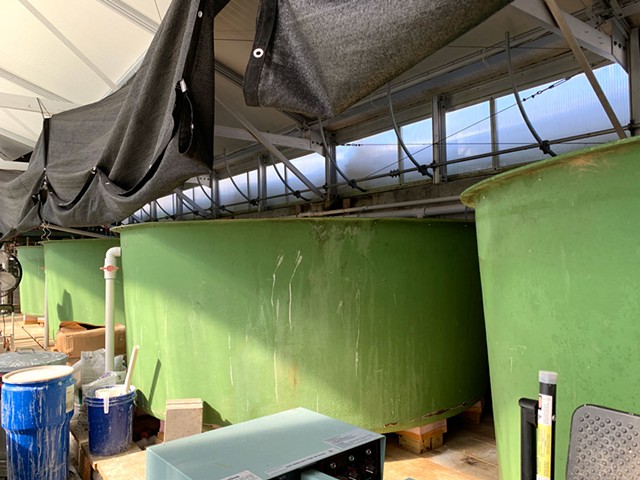
- Melissa Pasanen
- The tilapia tanks at Finn & Roots
Willis described tilapia as the top fish farmed globally, with a flaky, white, neutral-tasting flesh that makes it "the tofu of the fish world." But tilapia has no natural Vermont connection, as opposed to trout, which is the state's most common aquaculture product and sold mostly to stock ponds.
Even if Vermonters warmed to homegrown tilapia, Willis said, it cannot compete with the price of Asian imports, especially given processing costs. Buying whole fish is common around the world, but in the U.S., it's all about fillets: "Americans cannot handle their food looking back at them," he said.
In 2021, Beaver experimented with selling whole tilapia to longtime customer Sweet Clover Market in Essex. The store's general manager, Becca Herwood, has bought lettuce and cucumbers from Finn & Roots since its start and said the farm's artisan greens mix is Sweet Clover's bestselling salad product year-round. "It stays freshest the longest," she said.
Herwood said the environmental benefits of aquaponics appealed to her, as did selling locally farmed tilapia. The fish were delivered whole, and a butcher on staff gutted and scaled them before they were frozen.
But even three fish a week didn't sell quickly. Herwood thinks fillets would have moved better: "Unless you're a chef, most people don't know what to do with a whole fish."
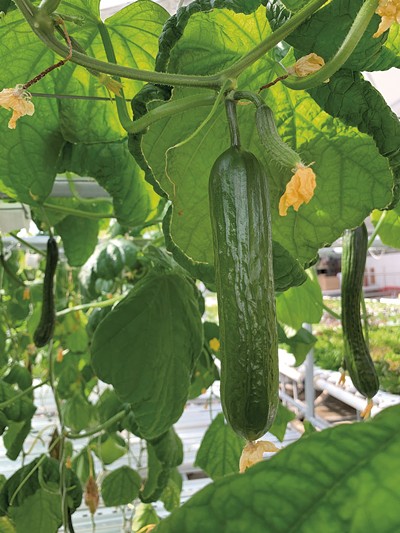
- Melissa Pasanen
- Finn & Roots' hydroponic cucumbers receive water from the tilapia tanks.
Doug Paine may know what to do with them, but would he buy them? After a recent taste test, the executive chef of Hotel Vermont's Juniper Bar & Restaurant and Bleu Northeast Kitchen in Burlington shared reservations about Finn & Roots tilapia.
Paine has bought the farm's lettuce periodically and is always seeking Vermont fish, which he said is hard to find. He buys local lake perch year-round and sources Vermont-raised shrimp and trout farmed in Vermont or New Hampshire.
In March, Paine cooked some Finn & Roots tilapia and said he was disappointed to find they tasted "musty and basement-y." These are off-flavors that the chef said he finds mostly in farmed fish.
The farm could probably remediate that problem by moving the fish to a clean tank for a week before harvest. However, even with that improvement, Paine said tilapia remains a relatively hard sell in the restaurant market. Compared with favorites such as salmon or tuna, "[they] don't have great cachet," he acknowledged.
Beaver has decided to cut back the aquaculture part of her operation to a few hundred fish that produce water to nourish the cucumbers and a new offering: hydroponic tomatoes. In the summer, she will apply it occasionally to the greens and herbs. The decision will oblige her to tweak her branding and marketing materials.
The good news is that demand for Finn & Roots greens is strong, especially in winter and spring. A couple of weeks ago, Beaver said, she beat all previous records for sales of her bestseller artisan mix of up to 10 varieties of greens, sending out 336 eight-ounce bags for delivery.
Make that mixed news, because her greenhouse has limited space to expand. "We're at capacity," Beaver said. "Everything about this place is bittersweet."
Despite those disappointments, the farmer said she is finally in that happy place she dreamed about back in Colorado. Once she surmounted the initial unexpected surprises, she found that puzzling her way through ongoing challenges "is what keeps me going. As long as there's a fix, something we can improve on, I'm happy as a clam," Beaver said.
This year, she added, "will be the first that we have any hope of moving the dial from loss toward profit." Beaver hopes that might allow her patient and supportive husband to finally quit his job.









Comments
Comments are closed.
From 2014-2020, Seven Days allowed readers to comment on all stories posted on our website. While we've appreciated the suggestions and insights, right now Seven Days is prioritizing our core mission — producing high-quality, responsible local journalism — over moderating online debates between readers.
To criticize, correct or praise our reporting, please send us a letter to the editor or send us a tip. We’ll check it out and report the results.
Online comments may return when we have better tech tools for managing them. Thanks for reading.